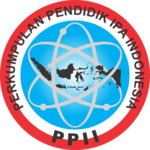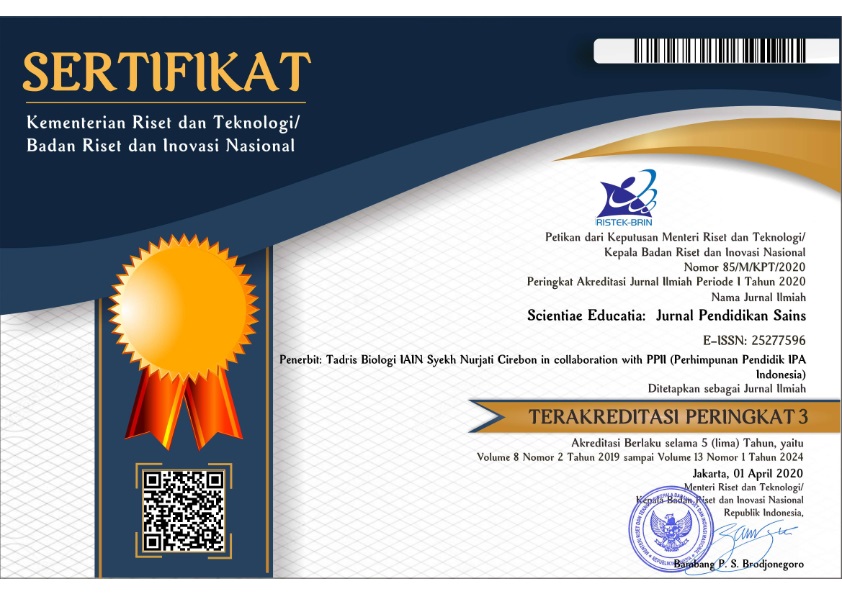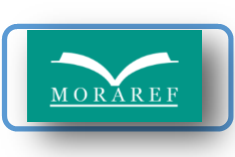Ethnoscience Study of the Application and Delivery Procession of Adat Melayu Jambi as Science Learning Resources
(1) Department of Physics Education, Faculty of Teacher Training and Education, Universitas Jambi
(2) Department of Physics Education, Faculty of Teacher Training and Education, Universitas Jambi
(3) Department of Physics Education, Faculty of Teacher Training and Education, Universitas Jambi
(4) Department of Physics Education, Faculty of Teacher Training and Education, Universitas Jambi
(5) Department of MathematicsEducation, Faculty of Teacher Training and Education, Universitas Jambi
(*) Corresponding Author
Abstract
Keywords
Full Text:
PDFReferences
Basuki, F. R., Jufrida & Suryanti, K. (2019). Identification of potential local wisdom of Senamat Ulu Village (Electrical Independent Village) as a source of science learning. IOP Conf. Series: Journal of Physics: Conf. Series1185 (2019) 012102. doi:10.1088/1742-6596/1185/1/012102.
Battiste, M. (2005). Indigenous Knowledge: Foundation for First Nations. Canada: University of Saskatchewan.
Fitriani, N. I., & Setiawan, B. (2017). Efektivitas modul ipa berbasis ethnoscience terhadap peningkatan keterampilan berpikir kritis siswa. Jurnal Penelitian Pendidikan IPA, 2(2), 71-76.
Gafar, A. (2012). Peranan seloko dalam upacara adat perkawinan masyarakat di Kota Jambi. Pena, 2(3), 45.
Ibe, E, & A. Nwosu, A. (2017). Effects of ethnoscience and traditional laboratory practical on science process skills acquisition of secondary school biology students in Nigeria. British Journal of Multidisciplinary and Advanced Studies, 1(1), 35-46.
Jufrida, Basuki, F. R., & Rahma, S. (2018). Potensi kearifan lokal geopark Merangin sebagai sumber belajar sains di SMP. Edufisika: Jurnal Pendidikan Fisika, 3(1), 1-15 doi: 10.22437/edufisika.v3i01.5773
Jufrida, Basuki, F. R., & Pratiwi, D. R. (2018). The potential of local wisdom on traditional fishing (tangkul) gear in Lake Sipin Jambi City as a Science Learning Source. Scientiae Educatia: Jurnal Pendidikan Sains, 7(2), 146-158. doi: 10.24235/sc.educatia.v7i2.2858
Lia, R. M., W. Udaibah., & Mulyatun. (2016). Pengembangan modul pembelajaran kimia berorientasi ethnoscience dengan mengangkat budaya batik Pekalongan. Unnes Science Education Journal, 5(3), 14-19. Retrieved from https://journal.unnes.ac.id/sju/index.php/usej/article/view/13174
Nisa, A., Sudarmin., & Samini. (2015). Efektivitas penggunaan modul terintegrasi ethnoscience dalam pembelajaran berbasis masalah untuk meningkatkan literasi sains siswa. Unnes Science Education Journal, 4(3), 1049-1056.
Novitasari, L., Agustina, P. A., Sukesti, R., Nazri, M. F., & Handhika, J. (2017, August). Fisika, etnosains, dan kearifan lokal dalam pembelajaran sains. In Prosiding SNPF (Seminar Nasional Pendidikan Fisika) (pp. 81-88).
Nuroso, H., & Sudarmin, S. (2018, March). Identification of indigenous science in the brick-making process through ethnoscience study. In Journal of Physics: Conference Series (Vol. 983, No. 1, p. 012172). IOP Publishing. doi: 10.1088/1742-6596/983/1/012172.
Okwara, O. K., & Upu, F. T. (2017). Effects of ethno-science instructional approach on students’ achievement and interest in upper basic science and technology in Benue State, Nigeria. International Journal of Scientific Research in Education,10(1), 69-78.
Parmin, Sajidan, Ashadi, & Sutikno. (2015). Skill of prospective teacher in integrating the concept of science with local wisdom model. Jurnal Pendidikan IPA Indonesia, 4(2), 120-126.
Phiri, A. D. K. (2008). Exploring the integration of indigenous science in the primary school science curriculum in Malawi. Dissertation Unpublished. Virginia Polytechnic Institute and State University.
Rahayu, W. E., & Sudarmin. (2015). Pengembangan modul IPA terpadu berbasis ethnoscience tema energy dalam kehidupan untuk menanamkan jiwa konservasi siswa. Unnes Science Education Journal, 4 (2), 920-926.
Rosyidah, A. N., Sudarmin, S. S., & Siadi, K. K. (2013). Pengembangan Modul IPA Berbasis Etnosains Zat Aditif dalam Bahan Makanan untuk Kelas VIII SMP Negeri 1 Pegandon Kendal. Unnes Science Education Journal, 2(1), 133-139.
Sudarmin, Febu, R., Nuswowati, M., & Sumarni, W. (2017). Development of Ethnoscience Approach in The Module Theme Substance Additives to Improve the Cognitive Learning Outcome and Student’s entrepreneurship. In Journal of Physics: Conference Series (Vol. 824, No. 1, p. 012024). IOP Publishing. doi:10.1088/1742-6596/824/1/012024.
Sudarmin, S., Selia, E., & Taufiq, M. (2018, March). The influence of inquiry learning model on additives theme with ethnoscience content to cultural awareness of students. In Journal of Physics: Conference Series (Vol. 983, No. 1, p. 012170). IOP Publishing. doi: 10.1088/1742-6596/983/1/012170
Sudarmin, S., Khusniati, M., Nur, F., Seyla, A., & Khoirur, R. (2018, September). Science Analysis of “Nginang “Culture In Context of Science Technology Engineering And Mathematics (Stem) Integration of Ethnoscience. In International Conference on Science and Education and Technology 2018 (ISET 2018, 247, 413-418.). Atlantis Press.
Sumarni, W, Sudarmin, Wiyanto, & Supartono. (2016). The Recontruction of Society Indigenous Science Into Scientific Knowledge in the Production Process of Palm Sugar. Journal of Turkish Science Education, 12 (4), 281-292. doi: 10.12973/tused.10185a.
Sugiyono. (2013). Metode Penelitian Kuantitatif, Kualitatif dan R & D. Bandung: Alfabeta.
DOI: 10.24235/sc.educatia.v8i2.4428
Article Metrics
Abstract view : 186 timesPDF - 119 times
Refbacks
- There are currently no refbacks.
Scientiae Educatia: Jurnal Pendidikan Sains indexed by:

This work is licensed under a Creative Commons Attribution 4.0 International License.
Stat Counter (Link)



1.png)












